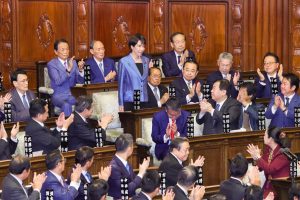The leaders of the ruling Liberal Democratic Party (LDP) and the opposition Nippon Ishin no Kai (Japan Innovation Party) formally signed a coalition agreement on October 20 at the Diet building. The coalition deal guaranteed Takaichi Sanae’s election as Japan’s first female prime minister in the prime ministerial nomination election on October 21.
“I look forward to working together to reshape Japan in a way that we can responsibly pass on to future generations,” Takaichi, the newly installed LDP leader, said.
“We share the same national vision and the desire to strengthen Japan. As a reformist party, we want to push forward the reforms we’ve advocated so far,” Nippon Ishin leader and Osaka Governor Yoshimura Hirofumi said.
On October 10, Komeito decided to end its 26-year alliance with the LDP. That left the LDP scrambling to find a new coalition partner, as even with Komeito’s seats the LDP was short of a majority.
The LDP and Nippon Ishin held a second round of policy talks on October 17. After the talks, Nippon Ishin co-leader Fujita Fumitake, a lower house member representing an Osaka district, said the two sides had made great progress and that final adjustments were underway on the wording and interpretation of Ishin’s policy proposals.
Meanwhile, Fujita said Nippon Ishin would no longer participate in policy discussions with the Constitutional Democratic Party of Japan (CDP) and the Democratic Party for the People (DPFP). Earlier, the three parties had explored the possibility of forming an alliance to block Takaichi’s path and elect an opposition-backed prime minister instead.
Nippon Ishin shares the LDP’s stances on constitutional revision and national security but promotes its own flagship policies. Their talks focused on several contentious issues, including Nippon Ishin’s proposals to cut the number of parliamentary seats, create a “backup capital” outside Tokyo, tighten restrictions on political donations from companies and organizations, lower social insurance premiums, and reduce the consumption tax.
The proposal on political donations is a sensitive issue for the LDP. The party collected about 2.4 billion yen ($16 million) from companies and industry groups in 2023. Although this was down 1.9 percent from the previous year (the first decline in three years), it still accounted for nearly 10 percent of the party’s total income.
In late 2023, the LDP became embroiled in a “slush fund” scandal, when it was discovered that politicians had been pocketing income from donations that exceeded the party’s fundraising quotas. Over 600 million yen had gone unreported. In response, the LDP disbanded its internal factions, but opposition parties accused it of defanging legislation designed to regulate future political donations. The scandal – and the LDP’s tepid response – contributed to the party’s loss of its majority in the 2024 lower house elections.
Besides political donation reform, Yoshimura said on TV Asahi that his party was seeking a 10 percent reduction in parliamentary seats to improve efficiency and lower costs – an election pledge made during the party’s lower house campaign last year. “That’s a definite condition for forming a coalition,” Yoshimura later emphasized on Fuji TV.
In response to Nippon Ishin’s requests, the coalition agreement signed on October 20 includes passing legislation during the extraordinary Diet session to cut the number of Diet members by 10 percent and reduce social insurance premiums. The agreement also stated that the two parties will work together on establishing a “backup capital” outside Tokyo in the event of a disaster or other emergency. However, the parties did not agree on whether to abolish corporate and organizational donations or to cut the consumption tax.
Founded as a center-right and reformist party in Osaka in 2015, Nippon Ishin’s current leadership – Yoshimura and co-leader Fujita – both hail from the area, where the party holds overwhelming dominance. It controls 17 of Osaka’s 18 lower house district seats and 19 upper house seats, but it has limited national reach, with only two district representatives from Tokyo. In contrast, the LDP currently holds no lower house district seats in Osaka and only six proportional representation seats in the wider Kinki bloc, which includes Osaka, Kyoto, Nara, Hyogo, Wakayama, and Shiga.
Nippon Ishin’s ties with the LDP date back to the days of former prime ministers Abe Shinzo (2012-2020) and Suga Yoshihide (2020-2021), who maintained cordial relations with Nippon Ishin’s early leaders, Hashimoto Toru and Matsui Ichiro.
Before entering the current coalition talks, the LDP and Nippon Ishin had cooperated in February. The two parties agreed to education and social welfare policies that would ensure the passage of the fiscal year 2025 budget. These policies centered on making senior high school education free and lowering social insurance premiums.
They agreed to a two-stage process to introduce free senior high school education. From fiscal year 2025, all public and private high school students will receive up to 118,000 yen in annual support, with the household income cap removed. From fiscal 2026, the subsidy for students at private schools will increase from a maximum of 396,000 yen to 457,000 yen per year, also without income restrictions. Foreign students expected to reside in Japan long-term will be eligible, but those temporarily studying in Japan will be excluded.
Even with Nippon Ishin’s cooperation, the LDP would still fall two votes short of the 233 needed for a majority in the 465-member lower house. However, Takaichi reached out to other parties to bridge the gap. Ultimately, she avoided a runoff in the prime ministerial vote on October 21 by winning 237 votes, securing victory in the first round.
Despite this success, she now faces the challenge of balancing concessions to Nippon Ishin’s policy demands – particularly in education and social insurance – while also working with opposition parties to secure support for future budgets. Additionally, she must tackle immediate economic and diplomatic challenges, including immediately hosting a visit from U.S. President Donald Trump, who arrives on October 27.





























